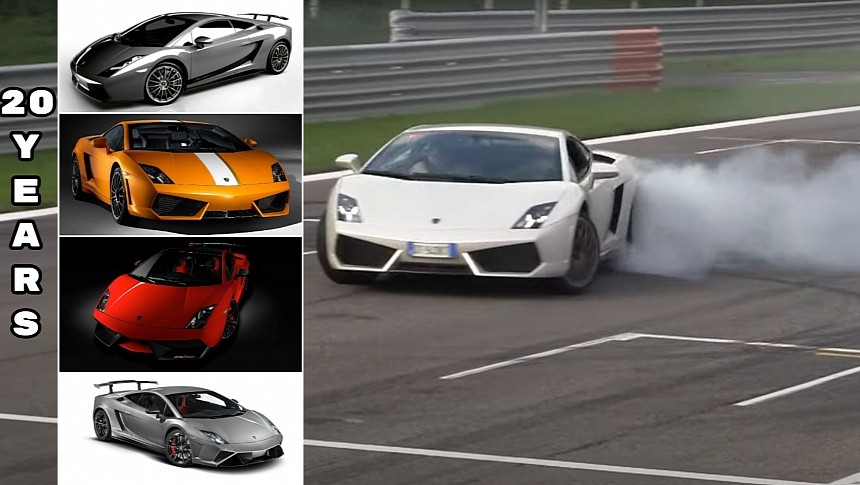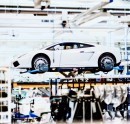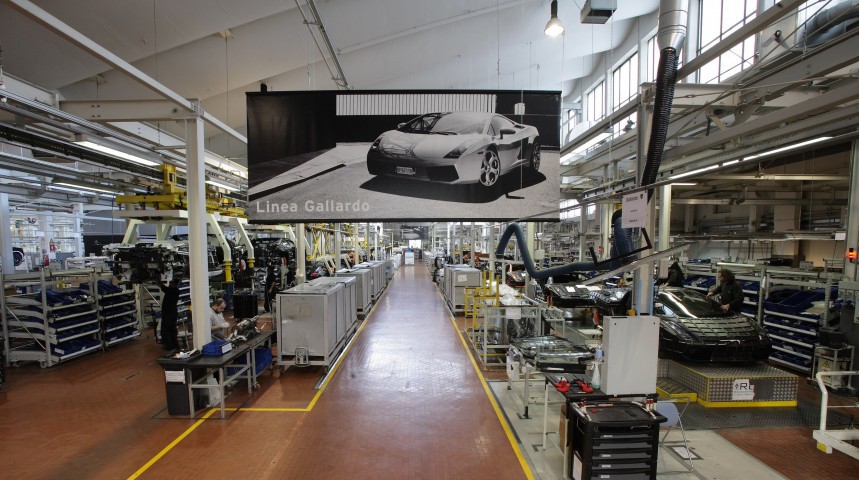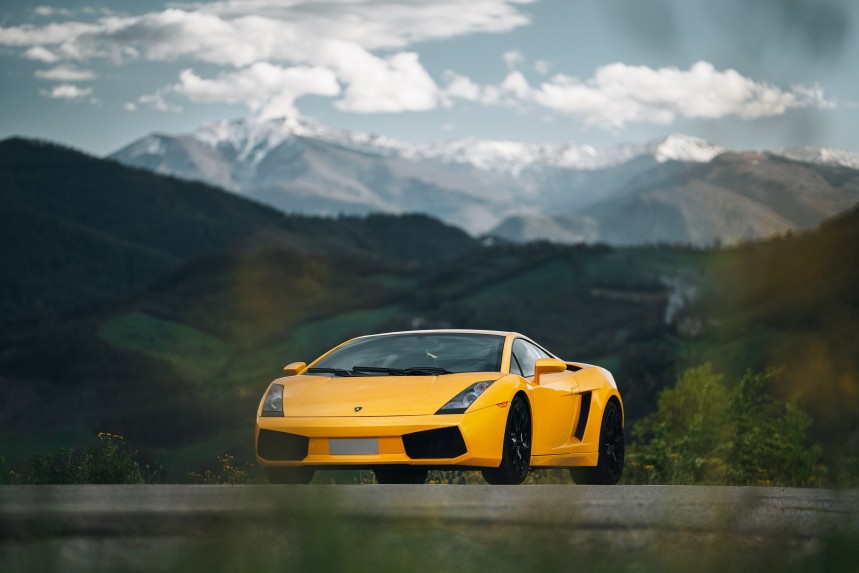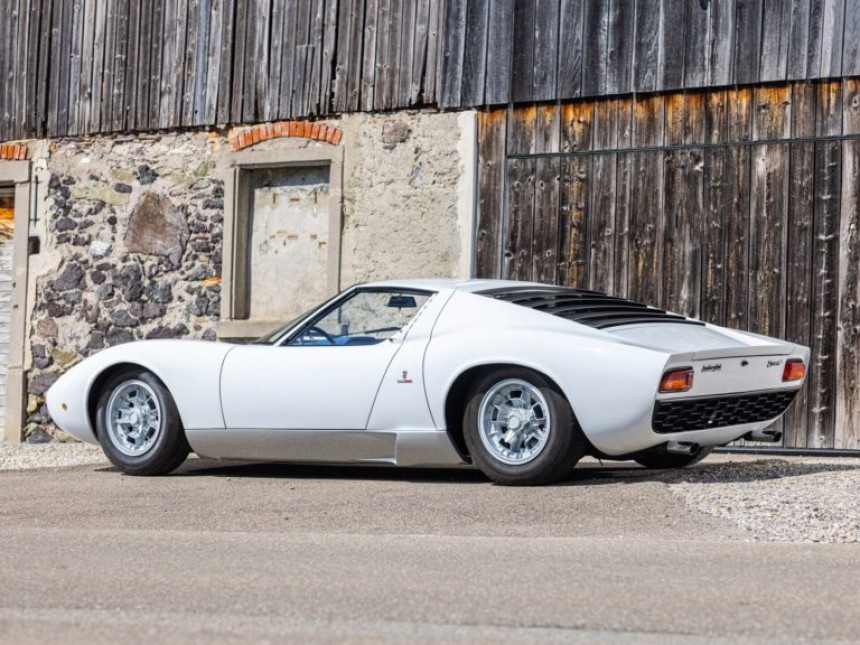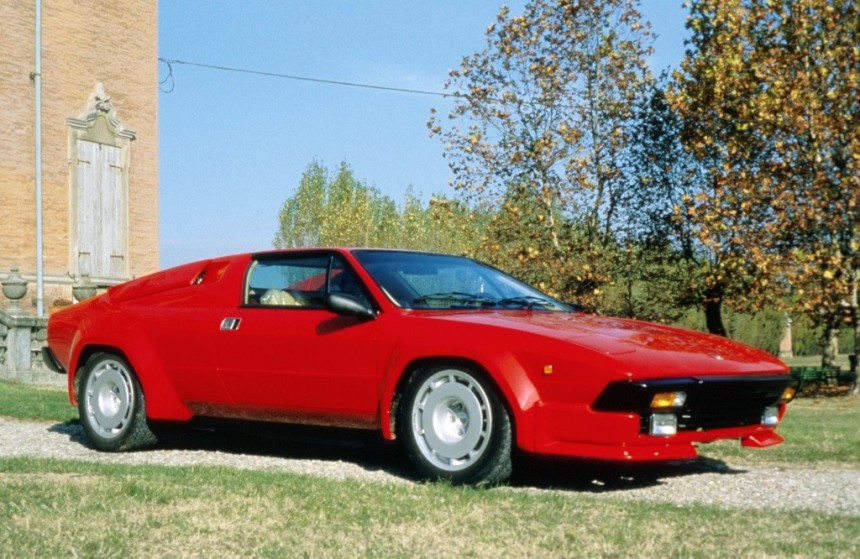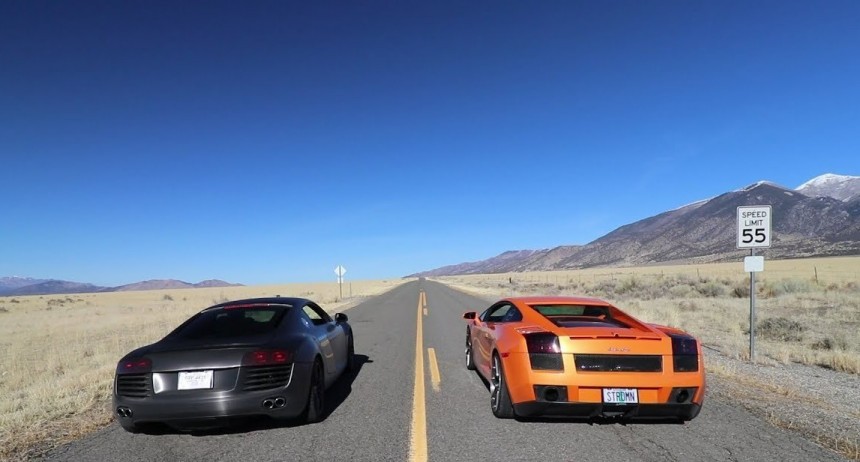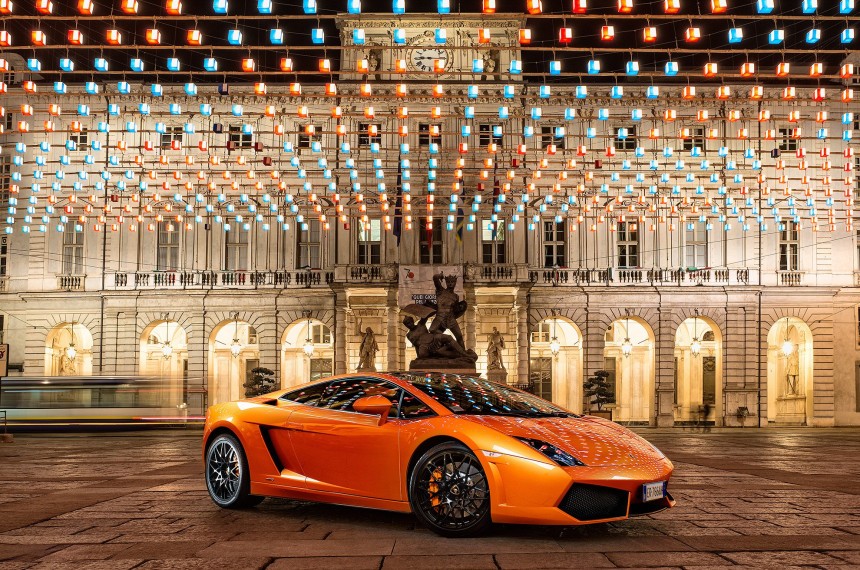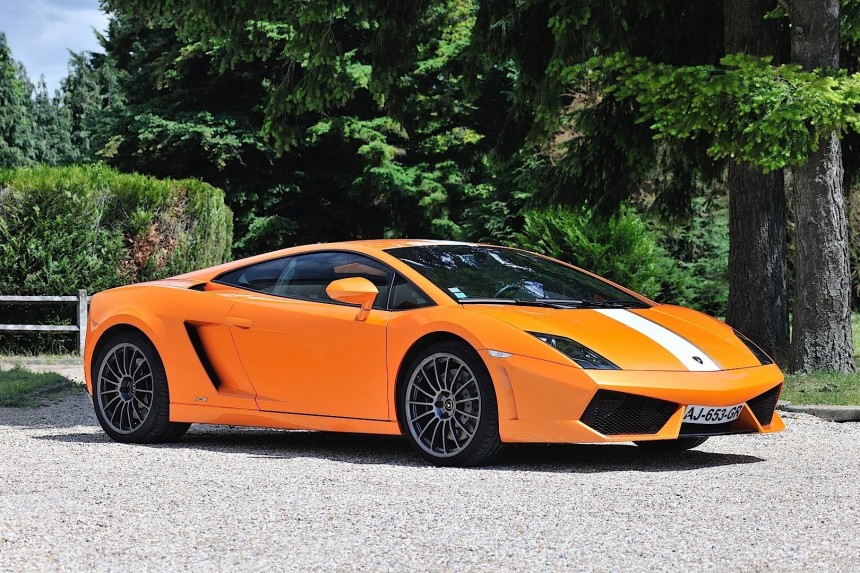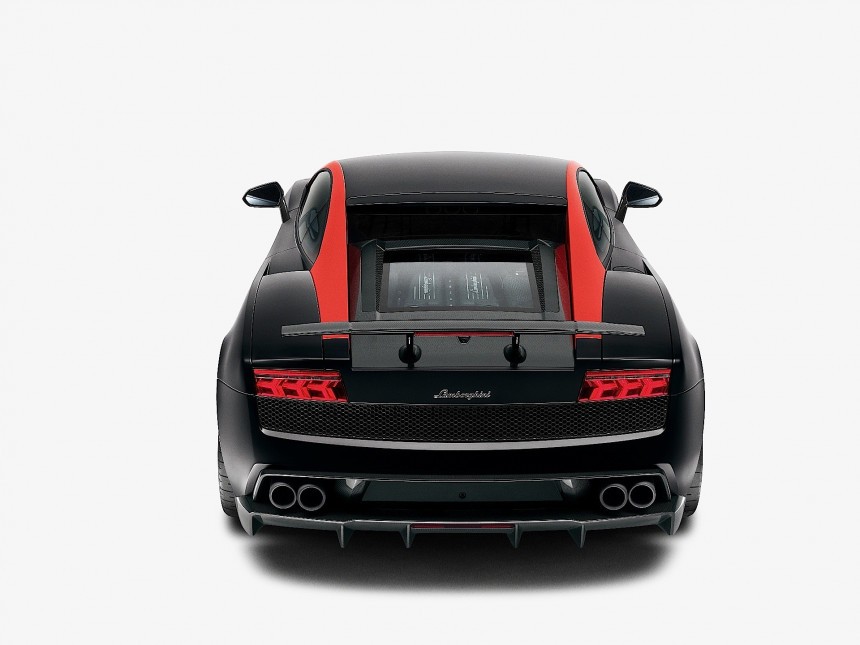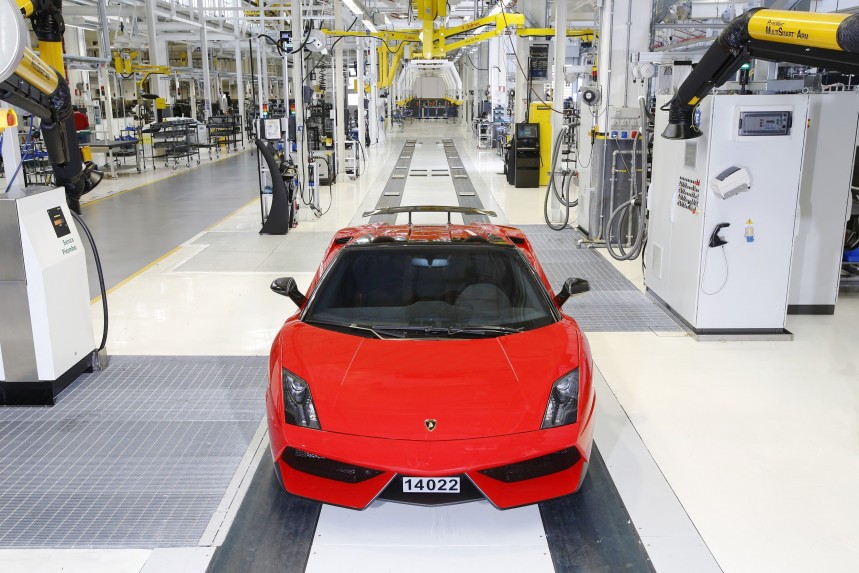My oh my, how time has passed! A little over two decades (20 years and four months, to be precise) ago, Lamborghini decided it was time to debut its first mass-production-ready V10 engine. It wanted to show the world that it could remove two cylinders and slightly downsize without compromising its modern V12-based DNA. The Italian marque created the Gallardo by putting that novel mechanical heart into a spiritual successor for the V8-powered Jalpa. Now, let's reminisce.
The "baby Lambo" moniker was first uttered publicly after the Gallardo was officially introduced as a production-ready model at the 73rd Geneva International Motor Show. It was the Italian brand's way of tackling the supercar dilemma with something cheaper than the big brother Murcielago, yet as or more appealing than the V12-powered icon.
But besides having a spanking-new V10 joining the raging bull stable, Gallardo's launch can be compared with Urus' unexpected appearance. It was bet Audi made while believing in what the Italian marque's founder said decades ago.
Here's its complicatedly beautiful story.
From 1990 until 2001, Lamborghini manufactured just one fantastic vehicle – the infamous Diablo. While it's true that the first three years of production overlapped with the appearance of the LM002, it's worth noting that nobody was enamored with it back then. Large boxy vehicles with a higher driving position made by an Italian brand whose reputation was about snappy supercars weren't quite what the people desired.
As such, Lamborghini ditched the LM002 (Urus' spiritual father) in 1993 and focused on Diablo and reaching profitability.
Keep in mind that the Diablo had a starting cost of around $240,000 ($560,000 in today's money). Thirty years ago, not many people were getting rich quickly off all sorts of stock market plays, social media shenanigans, real estate investments, and speculative buys of Internet coins.
But the Italian brand found itself under German ownership in 1998 and understood it had to diversify to continue living the dream of having more and more customers. The Diablo production ended in 2001, leaving its maker (and the new owners) in good spirits and with big plans for the future.
The first order of business? Replacing the old V12-powered supercar with a new one! Enter Murcielago – an amazingly-looking vehicle that wore the raging bull logo with confidence and pride.
But two years later, Lamborghini decided to give it a little sibling. So, the Gallardo joined the Italian marque's roster with two cylinders less, a slightly lower top speed, and a shrunken displacement. And boy, oh boy, what a marvelous decision that was!
While the base MSRP for a Murcielago was $273,000 ($470,592 in today's money), the Gallardo launched with a starting price tag of $198,000 ($328,324 adjusted to inflation). At first, only a few believed that a Lamborghini without the iconic butterfly doors would be successful. But after a decade, the V10-powered unit outsold its big brother more than thrice. It even outlived its sibling.
There were 4,001 Murcielagos made from 2001 to 2010 and over 14,002 Gallardos manufactured between 2003 and 2013. Depending on whom you ask, the actual production numbers may vary. But what remains true is that Gallardo brought the Italian brand great sales results, amounting to more than all the other Lamborghinis that went before it combined. Naturally, it became a legend, keeping this status among today's well-off gearheads.
But what the Gallardo arguably did best is that it vindicated the company's founder. Ferruccio Lamborghini gave Ferrari a masterclass lesson in competitiveness but also figured out that the market would welcome a tuned-down hardcore sports car.
Moreover, it has its own special place in the supercar hall of fame because it kickstarted a bloodline of V12 motoring royalty.
But the Miura is also "to blame" for overshadowing the Urraco – Lambo's attempt at convincing people that a more practical supercar with a downsized powerplant can work. Admittedly, it was uninspiringly launched right after the world's first supercar got discontinued.
Even though the V8-powered two-door four-seater Urraco held a lot of promise, it did not materialize during its seven years in production. Between 1972 and 1979, only 791 units were manufactured. They had an MSRP of $22,200 ($162,044 in 2023).
However, the eight-cylinder engine lived on with the Jalpa. It also had a seven-year run between 1981 and 1988 but flopped. That was despite the $58,000 ($149,589 in today's money) price tag. Lamborghini made just 410 models.
One might say that the Countach - Miura's successor - was to blame for this, but they would be wrong. The Jalpa represented a friendlier ride, it was cheaper, had better visibility, and was easier to daily than the iconic V12 Lambo spearhead of the '70s and '80s.
The carmaker simply allowed the $52,000 ($321,819 adjusted to inflation) Countach to eclipse the Jalpa. Nobody would dare to say that Lamborghini made a mistake or was uninspired in not promoting the Jalpa better, so we'll ride with what has already been said.
Between the Urraco and the Jalpa, the Italians also made the Silhouette. But with just 54 units leaving the factory at a starting price of $27,000 ($144,779 adjusted to inflation) and no real historical significance, we won't dwell on it.
If you managed to reach this part of the article, you might wonder, "What was on this guy's mind when he said that the Jalpa is Gallardo's spiritual predecessor?" Well, there's a reason for that!
But it took them 11 years to figure out that the Urraco recipe wasn't good enough for a simple reshuffle. Redesigning the Jalpa wasn't going to help either. As such, they had to start all over again. Moreover, financial troubles and uncertainties about the brand's future didn't support fruitful development.
It was no coincidence that the decision to recreate the "cheaper" Lambo was taken right after the VW-owned Audi finalized the purchase of Lamborghini from its Malay-Indonesian owners. Right after the transfer of ownership, the Ingolstadt-based automaker decided that Lamborghini had to return to its former glory.
First was the Murcielago, then the Gallardo. The new bosses were already envisioning a plan to reintroduce a Countach/Jalpa-like tandem.
The engineers and designers kept the initial plans concerning the concept and the dimensions but were dead-set on giving it a 10-cylinder heart. It was a first for the raging bull, so they had to tread carefully.
Massimo Ceccarani and Maurizio Reggiani, together with their teams, made the first 5.0-liter 500-hp V10 engine. They also succeeded each other in the role of Technical Director at the Italian marque.
Reggiani remembers that the first V10 powerplant they thought about before 1998 could have been better. The team was still heavily inclined to pick the V8 because it didn't have the gearbox integrated into the oil pan area like the OG 72-degree angle 10-cylinder, which would have meant the vehicle ending up with a high center of gravity.
After Audi stepped in, Lamborghini was tasked with creating a brand-new car based on an aluminum chassis, a novel V10, and a different transmission that had to be available as a manual and robotized.
This particular alloy includes approximately 17% silicon, which gives it the edge over the standard cast pistons. They keep their strength better when exposed to high heat. But the distribution was still chain-driven at that point, something only a few enthusiasts liked.
Gallardo also received an all-aluminum chassis that featured various implementations for adding body parts. Depending on the function, rivets, screws, or welding were used. The supercar also introduced thermoplastics for bumpers and other external hang-on parts.
After deciding on the technical side of things, the brand had to give the design a go. Luc Donckerwolke took over the brand-new Lamborghini Centro Stile and used the initial work of Italdesign Giugiaro to finish the car's appearance. That's when the raging bull began adopting aviation design cues.
They became obvious later through the market launch of the Aventador and the limited-edition Reventon.
Shortly after putting the Gallardo into production, Lamborghini had a great marketing idea – donating cars to various institutions like the Police. The supercars were also able to transport blood and donor organs quickly.
Pictures of the blue and white units with emergency lights are circulating on social media platforms even today, and the tradition of donating some V10-powered monsters to the Police continues. Last year, for example, a Huracan – Gallardo's successor – transported a kidney over a 300-mile route in just two hours.
Four years after the Gallardo launch, in 2007, Lamborghini saw that the model was pretty popular. So, it decided to create the Superleggera variant. Built around the idea of being lightweight, it shaved 220 lb and added 10 hp. It also came as standard with the robotized gearbox and optional carbon-ceramic brakes.
The Italians continued to make the Gallardo lighter through the extensive use of carbon fiber. The LP 560-4 version, launched in 2008, dropped another 44 lb over the Superleggera and introduced the 5.2-liter 552-hp engine with direct fuel injection.
The powerplant traded the regular firing order for increased crankshaft rigidity, increased efficiency, greater power, and less exhaust gasses. Until this point, all "baby Lambo" iterations were all-wheel drive.
The brand brought the Gallardo LP 550-2 Valentino Balboni one year later. Only 250 models were made, boasting rear-wheel drive and the Superleggera powertrain. But since the customer was always right and demand for tail-happy Gallardo was high, the special edition eventually wore production clothes. An open-top version was also created in 2011.
To make everything feel right about the rear-wheel-drive Gallardo, the engineers changed the suspension system, introduced new stabilizer bars, added a new rear differential, put new tires on it, and adjusted the dynamic stability system.
However, the 5.2-liter engine put out 570 hp – 40 hp more than the OG Superleggera and 18 hp more than the LP 560-4. To make it stick to the ground, some extensive aerodynamic work happened. The supercar had a new rear diffuser, a new floor, and a fixed rear spoiler.
The LP 570-4 Spyder Performante joined the Lamborghini stable a couple of months later with the same engine but less weight than the LP 560-4 Spyder. Dieting through the implementation of carbon fiber was a very real thing for the Italian marque.
Not ready to give up on the triumphant story of its first V10-powered supercar, Lamborghini went even further with the updates in 2012 and created the new Gallardo LP 560-4 and the Gallardo LP 570-4 Edizione Tecnica.
To close everything off with a bang, the raging bull logo was seen on one last iteration of the Gallardo – the limited-edition LP 570-4 Squadra Corse, inspired by the track-focused Gallardo Super Trofeo.
The story of the glorious supercar ended on November 25, 2013. A Gallardo LP 570-4 Spyder Performante finished in Rosso Mars left the Sant'Agata Bolognese factory, and, with it, the sun had set on a marvelous chapter of the Germano-Italic collaboration.
There's no denying that the Gallardo was put through quite the modification program throughout its unexpectedly long existence. Thus, we would be more inclined to go with one of the LP models. The price might be higher, but the nicer ride, the updated internals, and the worked-out bugs are just a few additions that make something like the LP 570-4 Superleggera more appealing.
It was quite the ride, but the Gallardo proved Ferruccio Lamborghini was right. The world wanted a more affordable Lamborghini, but the V8-powered Jalpa wasn't meant to be. The man and the car were simply ahead of their time.
But Ferruccio might be smiling now from wherever he may be. That's because the visionary and ambitious entrepreneur was doubly vindicated: the "baby Lambo" was a success that laid out the red carpet for the Huracan, while a V8 engine is now bestowing another great success of the Italian marque – the Urus, a delicious SUV that borrowed the LM002 heritage and got to market before the Ferrari Purosangue.
Now, onto better, greater things!
But besides having a spanking-new V10 joining the raging bull stable, Gallardo's launch can be compared with Urus' unexpected appearance. It was bet Audi made while believing in what the Italian marque's founder said decades ago.
Here's its complicatedly beautiful story.
As such, Lamborghini ditched the LM002 (Urus' spiritual father) in 1993 and focused on Diablo and reaching profitability.
Decisions, decisions
With a V12 under the hood and many variations along the way, the well-known supercar was Lamborghini's attempt at repositioning itself in the elite branch of automakers. The 11-year run saw a little over 2,903 units made, which was a resounding success back then. Still, more was needed to keep the company fully afloat.Keep in mind that the Diablo had a starting cost of around $240,000 ($560,000 in today's money). Thirty years ago, not many people were getting rich quickly off all sorts of stock market plays, social media shenanigans, real estate investments, and speculative buys of Internet coins.
But the Italian brand found itself under German ownership in 1998 and understood it had to diversify to continue living the dream of having more and more customers. The Diablo production ended in 2001, leaving its maker (and the new owners) in good spirits and with big plans for the future.
The first order of business? Replacing the old V12-powered supercar with a new one! Enter Murcielago – an amazingly-looking vehicle that wore the raging bull logo with confidence and pride.
While the base MSRP for a Murcielago was $273,000 ($470,592 in today's money), the Gallardo launched with a starting price tag of $198,000 ($328,324 adjusted to inflation). At first, only a few believed that a Lamborghini without the iconic butterfly doors would be successful. But after a decade, the V10-powered unit outsold its big brother more than thrice. It even outlived its sibling.
There were 4,001 Murcielagos made from 2001 to 2010 and over 14,002 Gallardos manufactured between 2003 and 2013. Depending on whom you ask, the actual production numbers may vary. But what remains true is that Gallardo brought the Italian brand great sales results, amounting to more than all the other Lamborghinis that went before it combined. Naturally, it became a legend, keeping this status among today's well-off gearheads.
But what the Gallardo arguably did best is that it vindicated the company's founder. Ferruccio Lamborghini gave Ferrari a masterclass lesson in competitiveness but also figured out that the market would welcome a tuned-down hardcore sports car.
Going back in time
Why use the "tuned-down hardcore sports car" term? Well, the secretly-developed Miura is responsible for coining the term supercar during its six years in production, so we won't call anything before it as such. It was the first vehicle developed from the ground up as a road-going, racing homologation-ignoring, transcendentally-beautiful passenger car that went very fast by those days' standards.But the Miura is also "to blame" for overshadowing the Urraco – Lambo's attempt at convincing people that a more practical supercar with a downsized powerplant can work. Admittedly, it was uninspiringly launched right after the world's first supercar got discontinued.
Even though the V8-powered two-door four-seater Urraco held a lot of promise, it did not materialize during its seven years in production. Between 1972 and 1979, only 791 units were manufactured. They had an MSRP of $22,200 ($162,044 in 2023).
However, the eight-cylinder engine lived on with the Jalpa. It also had a seven-year run between 1981 and 1988 but flopped. That was despite the $58,000 ($149,589 in today's money) price tag. Lamborghini made just 410 models.
One might say that the Countach - Miura's successor - was to blame for this, but they would be wrong. The Jalpa represented a friendlier ride, it was cheaper, had better visibility, and was easier to daily than the iconic V12 Lambo spearhead of the '70s and '80s.
Between the Urraco and the Jalpa, the Italians also made the Silhouette. But with just 54 units leaving the factory at a starting price of $27,000 ($144,779 adjusted to inflation) and no real historical significance, we won't dwell on it.
If you managed to reach this part of the article, you might wonder, "What was on this guy's mind when he said that the Jalpa is Gallardo's spiritual predecessor?" Well, there's a reason for that!
Playing around until something good is found
In 1987, one year before the Jalpa was discontinued, the Italian brand worked to develop the proper "compact Lamborghini." So, they experimented with V8 and V10 powertrains.But it took them 11 years to figure out that the Urraco recipe wasn't good enough for a simple reshuffle. Redesigning the Jalpa wasn't going to help either. As such, they had to start all over again. Moreover, financial troubles and uncertainties about the brand's future didn't support fruitful development.
First was the Murcielago, then the Gallardo. The new bosses were already envisioning a plan to reintroduce a Countach/Jalpa-like tandem.
The engineers and designers kept the initial plans concerning the concept and the dimensions but were dead-set on giving it a 10-cylinder heart. It was a first for the raging bull, so they had to tread carefully.
Massimo Ceccarani and Maurizio Reggiani, together with their teams, made the first 5.0-liter 500-hp V10 engine. They also succeeded each other in the role of Technical Director at the Italian marque.
Reggiani remembers that the first V10 powerplant they thought about before 1998 could have been better. The team was still heavily inclined to pick the V8 because it didn't have the gearbox integrated into the oil pan area like the OG 72-degree angle 10-cylinder, which would have meant the vehicle ending up with a high center of gravity.
Listening to the Germans
That's how the 90-degree angle 5.0-liter 10-cylinder with regular firing intervals (thanks to four valves per cylinder) appeared. Hypereutectic aluminum alloy was used for the pistons, which "allowed the liner to be cast directly on the aluminum," as Reggiani himself said.This particular alloy includes approximately 17% silicon, which gives it the edge over the standard cast pistons. They keep their strength better when exposed to high heat. But the distribution was still chain-driven at that point, something only a few enthusiasts liked.
Gallardo also received an all-aluminum chassis that featured various implementations for adding body parts. Depending on the function, rivets, screws, or welding were used. The supercar also introduced thermoplastics for bumpers and other external hang-on parts.
After deciding on the technical side of things, the brand had to give the design a go. Luc Donckerwolke took over the brand-new Lamborghini Centro Stile and used the initial work of Italdesign Giugiaro to finish the car's appearance. That's when the raging bull began adopting aviation design cues.
They became obvious later through the market launch of the Aventador and the limited-edition Reventon.
Pictures of the blue and white units with emergency lights are circulating on social media platforms even today, and the tradition of donating some V10-powered monsters to the Police continues. Last year, for example, a Huracan – Gallardo's successor – transported a kidney over a 300-mile route in just two hours.
Making all the right moves
Two years after introducing the Gallardo in coupe form, Lamborghini also launched the Spyder version. It debuted in 2005 with 20 hp more and a manual gearbox with a shorter gear ratio. The e-gear transmission was optional. One year later, the coupe got these upgrades as well.Four years after the Gallardo launch, in 2007, Lamborghini saw that the model was pretty popular. So, it decided to create the Superleggera variant. Built around the idea of being lightweight, it shaved 220 lb and added 10 hp. It also came as standard with the robotized gearbox and optional carbon-ceramic brakes.
The Italians continued to make the Gallardo lighter through the extensive use of carbon fiber. The LP 560-4 version, launched in 2008, dropped another 44 lb over the Superleggera and introduced the 5.2-liter 552-hp engine with direct fuel injection.
The powerplant traded the regular firing order for increased crankshaft rigidity, increased efficiency, greater power, and less exhaust gasses. Until this point, all "baby Lambo" iterations were all-wheel drive.
To make everything feel right about the rear-wheel-drive Gallardo, the engineers changed the suspension system, introduced new stabilizer bars, added a new rear differential, put new tires on it, and adjusted the dynamic stability system.
Can't stop, won't stop
Seeing just how popular the Gallardo was after selling well over 9,000 units, the automaker moved forward with the modifications and overhauled the all-wheel-drive 2007 Superleggera. It became the Gallardo LP 570-4 Superleggera in 2010. It weighed 154 lb less than the original version, translating into 110 lb less than the 2008 LP 560-4 unit.However, the 5.2-liter engine put out 570 hp – 40 hp more than the OG Superleggera and 18 hp more than the LP 560-4. To make it stick to the ground, some extensive aerodynamic work happened. The supercar had a new rear diffuser, a new floor, and a fixed rear spoiler.
The LP 570-4 Spyder Performante joined the Lamborghini stable a couple of months later with the same engine but less weight than the LP 560-4 Spyder. Dieting through the implementation of carbon fiber was a very real thing for the Italian marque.
To close everything off with a bang, the raging bull logo was seen on one last iteration of the Gallardo – the limited-edition LP 570-4 Squadra Corse, inspired by the track-focused Gallardo Super Trofeo.
The story of the glorious supercar ended on November 25, 2013. A Gallardo LP 570-4 Spyder Performante finished in Rosso Mars left the Sant'Agata Bolognese factory, and, with it, the sun had set on a marvelous chapter of the Germano-Italic collaboration.
One for the history books
Today, gearheads are more interested in buying pre-LP Gallardos. They are considered more reliable than Ferraris of the same period and even the refreshed Gallardos that followed after 2007. However, some claim that the LP vehicles are better and underline that sharing more parts with Audi may help those owning a Gallardo today enjoy cheaper repairs and find parts easier.It was quite the ride, but the Gallardo proved Ferruccio Lamborghini was right. The world wanted a more affordable Lamborghini, but the V8-powered Jalpa wasn't meant to be. The man and the car were simply ahead of their time.
But Ferruccio might be smiling now from wherever he may be. That's because the visionary and ambitious entrepreneur was doubly vindicated: the "baby Lambo" was a success that laid out the red carpet for the Huracan, while a V8 engine is now bestowing another great success of the Italian marque – the Urus, a delicious SUV that borrowed the LM002 heritage and got to market before the Ferrari Purosangue.
Now, onto better, greater things!
